Where should I keep a fire extinguisher in my home?
Don’t mount it too close to where a fire is likely to occur. For example, don’t keep it next to the stove. A good place is at the top of the... More »
According to the National Fire Protection Association, each year approximately 400,000 house fires are reported. What’s most alarming is that nearly 3,500 people are killed in house fires each year. Sadly, many fire prevention experts agree that the majority of these deaths are preventable. In this video we’ll be discussing fire safety, and more precisely, how to survive a fire if one should happen in your home.
While watching some of the other videos on this website, you quickly realize there are many do-it-yourself projects that can help you solve a home maintenance issue or that might help increase the overall value of your home. Today we’re going to address one project that could potentially save your life, or the life of a family member.
According to the National Fire Protection Association, each year approximately 400,000 house fires are reported. What’s most alarming is that nearly 3,500 people are killed in house fires each year. Sadly, many fire prevention experts agree that the majority of these deaths are preventable. In this video we’ll be discussing fire safety, and more precisely, how to survive a fire if one should happen in your home.
There are many ways to prevent fires from happening. Spend time researching the leading causes of house fires and how to prevent them in your home. Also, make you’re your family has an exit strategy in case of fire, and rehearse it regularly to make sure everybody knows what to do. Check out our frequently asked questions for this video for more information and additional resources. Remember, preventive measures should always be your first priority, because the best way to survive a fire is to make sure one doesn’t start in the first place. But you need to be prepared in case one does, so first we’ll talk about the role smoke detectors play in saving lives, and where they should be placed in the home. Then, we’ll show you how to use a fire extinguisher in case you ever have to use one. So let’s get started.
According to the National Fire Protection Association, almost two-thirds of home fire deaths result in homes without working smoke alarms. The best way to make sure your smoke alarms work is to install new batteries every 6 months and to test them monthly. Many experts suggest changing batteries whenever you change your clocks in the spring and fall. Aside from the reminder, be sure to have plenty of batteries on hand, including both Double A and 9 volt batteries, which are common for smoke alarms.
Also check the date on the back of your smoke detector. If it’s more than 10 years old, you should replace it with a new one.
One of the most frequently asked questions consumers have about home fire safety is “how many smoke detectors do I need?” While it’s best to have at least one on every floor of the house, placed in a central location, be sure to read the manufacturer’s instructions for recommended locations that can have the greatest impact.
At a minimum, make sure you place them in the rooms where fires are most likely to start, such as the laundry room, the kitchen, the basement, and in all of the bedrooms in the home. In this home, the family has installed combination smoke and Carbon Monoxide detectors in the bedrooms as an extra safety precaution.
Some manufactures have even developed smoke alarms that use wireless technology to communicate with each other, so if one alarm in the house goes off, the others will too. In this case, we’ll place the wireless combination smoke and carbon monoxide alarm in the basement. Then we’ll place one smoke alarm on the main level of the home, and another in the hallway upstairs, just outside the bedrooms.
Suppose you’re upstairs and the smoke alarm goes off. You notice that the door is hot and the only way to escape is out the second story window. This is when an escape ladder can be a life saver. First open the window and secure the ladder bracket over the bottom of the window frame. Carefully lower the ladder, then carefully crawl out the window and down to safety. It’s a great last resort if you’re ever trapped by fire on the second story.
Now, suppose you’re in the kitchen and a fire breaks out on the stove top. While it has the potential to grow out of control, there’s still time to contain it. This is when having a fire extinguisher handy is vitally important. Four out of 10 house fires are related to cooking, so if you only have one fire extinguisher in your home, make sure it’s close to the kitchen.
Fighting a home fire yourself involves a great deal of risk, and much of this risk includes the threat of smoke inhalation. Always remember to call the fire department first if at all possible before fighting a fire yourself, and never turn your back on a fire, as it could flare up in an instant and become uncontrollable.
When choosing a fire extinguisher, be sure to select a type that’s appropriate for the situation. While all fire extinguishers are rated according to the type of fires they can control, most manufacturers label fire extinguishers for the areas of the home where they should be kept. This one, for example, is appropriate for garages and workshops. This one is designed for living areas. This one is perfect for the kitchen.
To use a fire extinguisher, simply pull the pin, step back 6 to 8 feet, squeeze the lever and sweep from side to side at the base of the fire. For more information on choosing and using a fire extinguisher, see our Frequently Asked questions for this video.
There you have it. Now you can rest easier knowing you’ve developed a plan and have taken the proper precautions to make sure you and your family can survive a fire if one should ever occur in your home. It’s one of the most important things you can do for your family’s well-being.
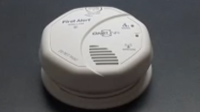
Make sure there is a smoke detector installed on every level of your home, and test them monthly. If the smoke detector is over 10 years old, replace it with a new one.
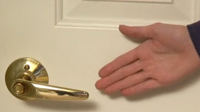
If you are in a room with a closed door when the alarm goes off, touch the door with the back of your hand to see if it's hot. Don't touch the door knob. If the door is hot, there might be a fire on the other side. Find an alternate route.
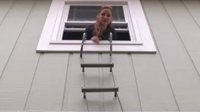
Have an escape ladder handy in every upstairs room in case your only means of escape is through the window.
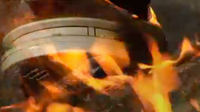
Always call the fire department first before putting out a fire.
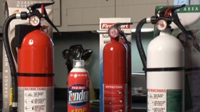
You should have at least one fire extinguisher near the kitchen. TO use an extiguisher, pull the pin, stand back 6 to 8 feet and squeeze the handle sweeping for side to side.
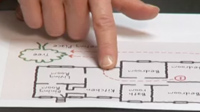
Make sure your family plans an exit strategy in place and practice it frequently.
Don’t mount it too close to where a fire is likely to occur. For example, don’t keep it next to the stove. A good place is at the top of the... More »
The fire rating is the length of time a door can resist the spread of a... More »
Drywall is not fire proof, but the fire resistance rating is the length of time a wall can withstand fire and serve as a barrier and keep it from... More »
A dry-chemical extinguisher marked general-purpose or multi-purpose is best for home... More »
Safety glass helps cut down on injuries from people falling against glass. Tempered glass is a type of safety glass. It shatters into small pieces... More »
Child-resistant locks on cabinets, electrical outlet covers, additional smoke alarms and gun locks are some of the products you should... More »
Child resistant locks on cabinets, electrical outlet covers, additional smoke alarms and gun locks are some of the products you should... More »
An ionization fire alarm is designed to detect a smoldering fire more quickly than a photoelectric smoke detector will. It should be used in rooms... More »
Thermal smoke detectors detect heat only. Ionization smoke detectors respond particularly well to smoke caused by flaming fires. Photoelectric smoke... More »
There are a variety of other trim options that can add a lot of detail to the entranceway. Options include caps or headers over the door, pilasters,... More »
In this first segment of our 3-part home weatherization series, we’re going to focus on areas of the house most prone to air infiltration. We’re... More »
In this final segment of our 3-part home weatherization series, we’ll be up in the attic preparing to add a layer of insulation. But before we... More »
In this second segment in our 3-part series, we’re going to focus on two key areas in the basement that are prone to leaking air. First, we’ll... More »
A combination smoke and carbon monoxide detector is one of the best ways to ensure your family’s safety. They save lives and they’re easy to... More »